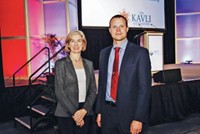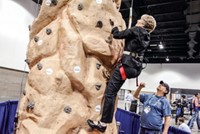Advertisement
Grab your lab coat. Let's get started
Welcome!
Welcome!
Create an account below to get 6 C&EN articles per month, receive newsletters and more - all free.
It seems this is your first time logging in online. Please enter the following information to continue.
As an ACS member you automatically get access to this site. All we need is few more details to create your reading experience.
Not you? Sign in with a different account.
Not you? Sign in with a different account.
ERROR 1
ERROR 1
ERROR 2
ERROR 2
ERROR 2
ERROR 2
ERROR 2
Password and Confirm password must match.
If you have an ACS member number, please enter it here so we can link this account to your membership. (optional)
ERROR 2
ACS values your privacy. By submitting your information, you are gaining access to C&EN and subscribing to our weekly newsletter. We use the information you provide to make your reading experience better, and we will never sell your data to third party members.
Policy
Chemists Meet In Utah
Nanoscience is the theme of society's Salt Lake City convention
by Linda R. Raber
March 30, 2009
| A version of this story appeared in
Volume 87, Issue 13

MORE THAN 10,700 chemical scientists and exhibitors converged on Salt Lake City last week for the 237th ACS national meeting. Attendees presented nearly 7,300 papers in 724 oral and poster sessions covering the spectrum of chemical sciences and technology. The meeting's theme was "Nanoscience: Challenges for the Future," and many nanoscience-specific symposia were integrated into the technical program.
Angela Belcher, a professor of chemistry at MIT, delivered the keynote address to a packed ballroom. She sketched out potential nanotechnology solutions to global challenges in energy, health care, and the environment. In the realm of energy, for example, she highlighted various groups' efforts to build nanostructured materials for use in batteries, fuel cells, and solar cells, as well as more efficient lights. Belcher also described her own lab's efforts to genetically coax viruses into growing new lithium-ion battery materials at room temperature.
At its open meeting, the board of directors honored five ACS leaders who have worked over the past several years as ACS Diversity Ambassadors by building relationships with a variety of organizations. Honored were Nancy B. Jackson, who works with the American Indian Science & Engineering Society; Paul Jones, for outreach to the National Organization of Gay & Lesbian Scientists & Technical Professionals; Howard Peters, for building relationships with the Society for Advancement of Chicanos/Latinos & Native Americans in Science; Marinda Wu, who focuses on outreach to people of Asian descent; and James P. Shoffner, who has fostered strong ties to the National Organization for the Professional Advancement of Black Chemists & Chemical Engineers.
At its meeting, the ACS Council heard various reports from society officials. The Committee on Budget & Finance reported that in 2008 the society's net from operations was $9.7 million, or $563,000 better than had been budgeted. This was based on total revenues of $458.8 million. However, the sharp decline in global capital markets weakened the society's overall financial position. A combination of sizable investment losses and a decline in the funded status of the society's defined-benefit pension plan, which required a charge against unrestricted net assets, caused ACS unrestricted reserves to dive from $212 million at the end of 2007 to $60 million at year's end. Thus, ACS ended the year in compliance with four out of five of its internally established financial guidelines; however, it did not meet the sustainability guideline, which measures reserve adequacy.
At their meeting, councilors voted, after strenuous debate, to increase ACS member dues for 2010 by $5.00 to $145. They also selected Jackson, manager of the International Chemical Threat Reduction Department at Sandia National Laboratories, and Cheryl A. Martin, elected corporate vice president of Rohm and Haas, as candidates for ACS president-elect in 2010. Jackson and Martin, along with any petition candidates, will stand for election this fall.
The ACS Career Fair hosted 611 job seekers and 32 employers, who posted 176 available positions. It was the lowest turnout for employers and job seekers in many years. The fall 2008 Career Fair in Philadelphia drew 1,266 job seekers to 84 employers, who posted 515 available positions.






Join the conversation
Contact the reporter
Submit a Letter to the Editor for publication
Engage with us on Twitter